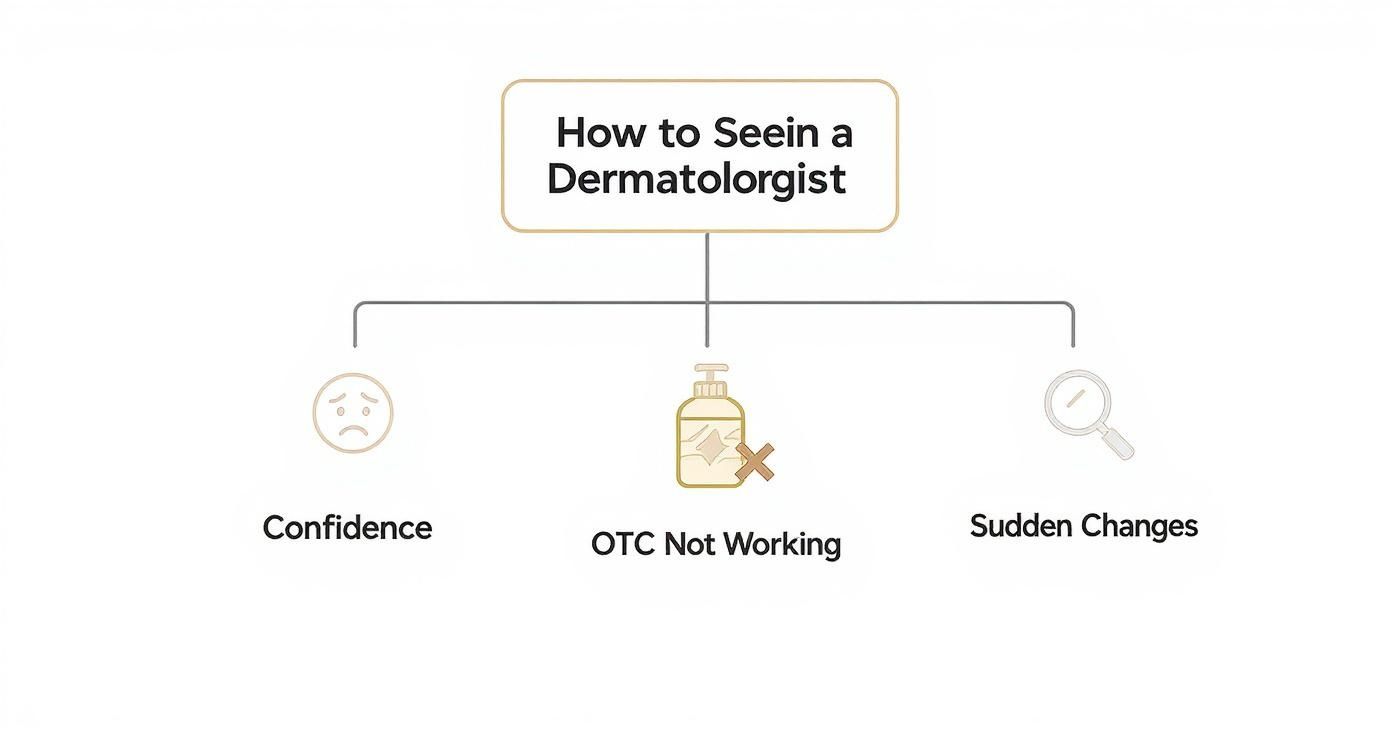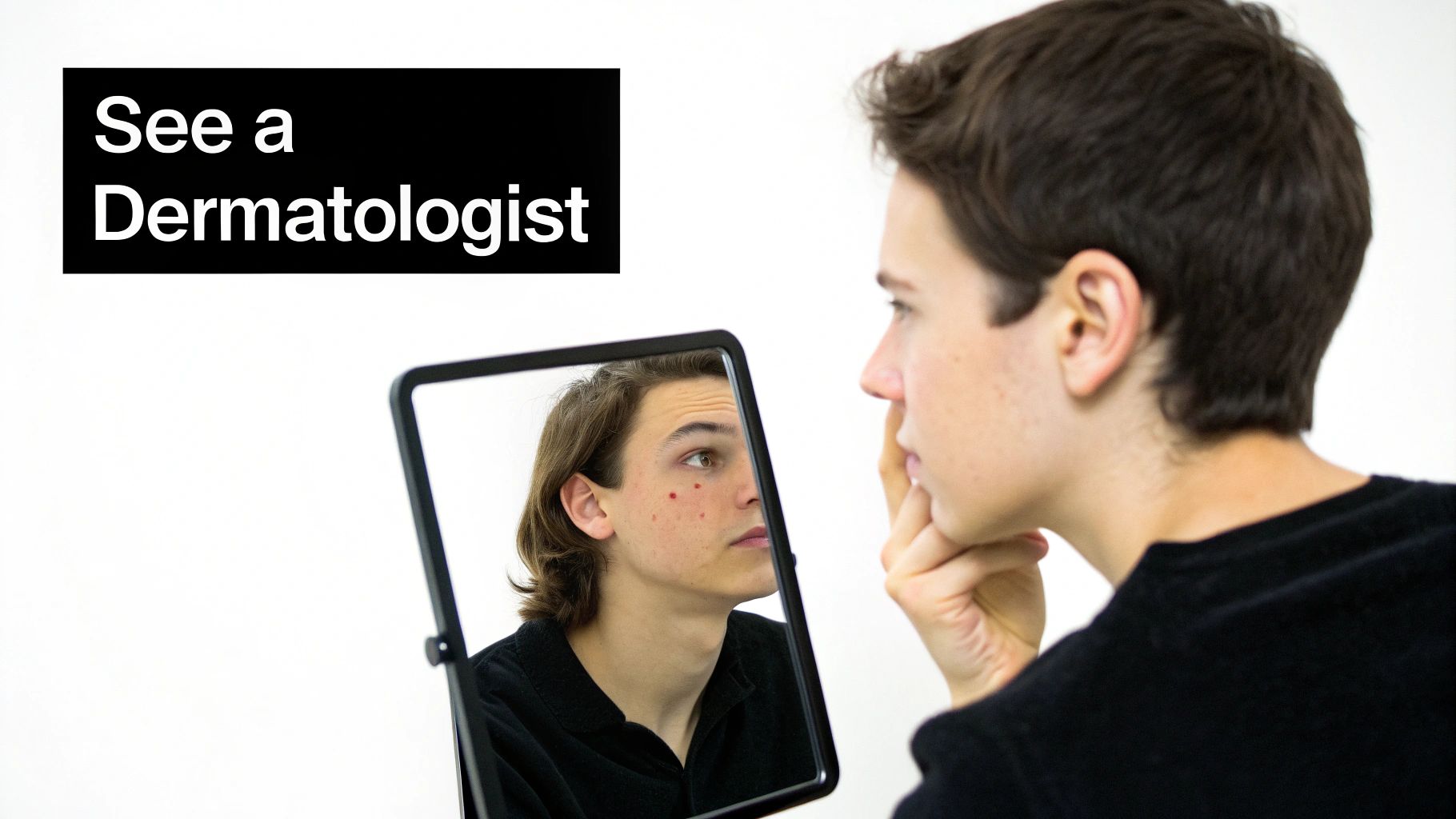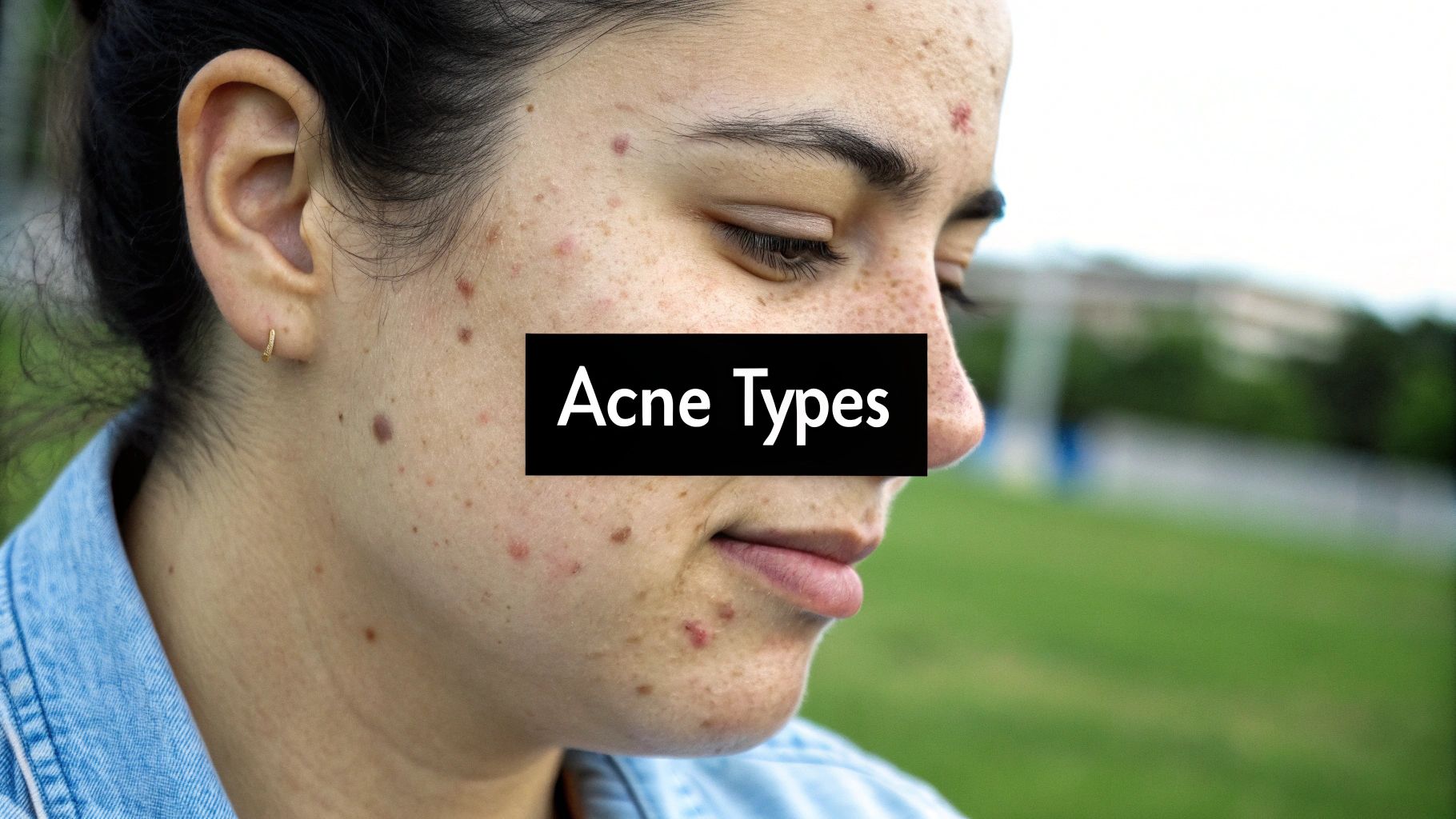When to See a Dermatologist: Signs You Need Professional Care

Staring at your reflection, wondering if that breakout has crossed the line from "annoying" to "time to call a professional"? It's a common question, and thankfully, the answer is usually pretty straightforward.
If your skin is starting to take a toll on your confidence, you’ve given over-the-counter products a fair shot for a few months with no luck, or you’re noticing sudden and unusual changes, it’s probably time to book an appointment.
Knowing When Your Skin Needs an Expert
Figuring out when to switch from at-home care to professional help can feel like a tough call. For many people, mild to moderate acne responds really well to a consistent, high-quality skincare system. Think of a well-formulated routine as your first line of defense, powered by ingredients proven to work.
For instance, products built around powerhouse ingredients like Salicylic Acid and Mandelic Acid are designed to get to the root of the problem. Salicylic Acid is a BHA (beta-hydroxy acid) that penetrates deep into pores to dissolve oil and dead skin cell buildup, while Mandelic Acid, a gentle AHA (alpha-hydroxy acid), exfoliates the skin’s surface, reduces inflammation, and helps fade post-acne marks. This is the science behind Neutralyze, which combines these clinically proven ingredients to deliver a multi-action attack on acne, making it an ideal starting solution.
Three Core Triggers for a Dermatologist Visit
But sometimes, even the most diligent at-home routine isn't enough. That’s not a failure on your part; it just means the underlying issue might need a medical diagnosis and prescription-strength treatments. Knowing the signs that you’ve hit this wall is key.
This decision tree breaks down the three main reasons you should think about scheduling that appointment.

As you can see, it's not just about the pimples themselves. It's also about how they're affecting your life and whether your current products are actually working. Your journey to clear skin is all about listening to what your skin is telling you.
The goal is to see significant improvement within 8-12 weeks. If your acne persists or worsens despite consistent use of a quality system, it's a clear sign that professional intervention is your next logical step.
Here’s a simple table to help you decide when to make the call.
Quick Guide for Booking a Dermatology Appointment
| Symptom or Concern | Effective At-Home Approach | When to See a Dermatologist |
|---|---|---|
| Occasional pimples, whiteheads, blackheads | A consistent routine with Salicylic or Mandelic Acid, like Neutralyze. | If it becomes widespread or doesn't clear up after 3 months. |
| Deep, painful cysts or nodules | At-home treatments can help with inflammation, but aren't a cure. | As soon as possible. These can lead to significant scarring. |
| Acne leaving dark spots or scars | Sunscreen and exfoliating acids can help fade marks. | If you notice pitted or indented scars forming. |
| Sudden, severe breakout with no clear cause | Stick to a gentle, non-irritating routine. | Immediately. It could signal an underlying health issue. |
| Acne is affecting your mental health | Taking control with a proven routine can boost confidence. | If your skin is causing anxiety, depression, or social withdrawal. |
By first trying a proven, ingredient-focused system like Neutralyze, you're not just treating your skin—you're gathering information. You'll learn what works for you, and if the time comes, you'll know you’ve done your part and are ready to hand the reins over to an expert for a more targeted plan.
Understanding Your Acne, From Bumps to Cysts

Acne isn't a one-size-fits-all problem, and knowing exactly what you're up against is the first real step toward getting clear skin. Think of it like this: some issues are just on the surface, while others are brewing deep underneath. Figuring out which one you have is key to knowing when it's time to call in a dermatologist.
Superficial blemishes, like blackheads and whiteheads, are essentially just clogged pores hanging out near the surface. Blackheads are open to the air, which causes the gunk inside to oxidize and turn dark, while whiteheads are sealed over. This is the kind of acne where the right ingredients can really work their magic.
Surface-Level Blemishes vs Deeper Issues
For mild-to-moderate acne, an intelligent combination of active ingredients is your most powerful tool. The dual-action formula in Neutralyze products is engineered specifically for these surface-level battles. Salicylic Acid is oil-soluble, meaning it can get past the skin's lipid layers and deep into the pores to break down the mix of sebum and dead skin cells that causes clogs. Simultaneously, Mandelic Acid works on the surface, gently exfoliating to prevent future blockages, reduce redness, and even out skin tone. This one-two punch is what makes it an effective initial solution for many.
But when acne gets inflamed, it's a whole different ballgame. This is when you start to see:
- Papules: Those small, red, and often tender bumps that don’t have a "head."
- Pustules: What most people call a pimple—an inflamed spot with a visible white or yellow center.
These are your skin's way of telling you that bacteria have crashed the party, triggering a much bigger fight. While a consistent over-the-counter routine can often keep this under control, it’s definitely a step up in seriousness.
When Acne Goes Deeper and Demands a Doctor
The real dividing line is when acne burrows deep into your skin, forming painful, hard lumps. We’re talking about nodules and cysts.
Nodules are hard, painful lumps that live beneath the skin’s surface. Cysts are similar, but they're filled with pus and are notorious for leaving behind significant scars. This is not something you can—or should—try to handle on your own.
This kind of severe acne is a clear signal to get a dermatologist involved. You'll likely need prescription-strength treatments to tackle that deep inflammation and prevent lasting damage to your skin. Trying to pop or treat cystic acne at home is a fast track to scarring that can be tough to get rid of later. If you're already dealing with scars, learning about professional options like Microneedling vs Chemical Peel for acne scars can help you have a more informed conversation with an expert.
It's no surprise that acne is one of the top reasons people see a skin specialist. In fact, in 2023, acne treatments made up about 42.8% of all dermatology services worldwide. If your acne has gotten severe, our guide on how to treat severe acne can give you more context before you head to your appointment.
When Your Routine Stops Working and You've Hit a Wall
It's one of the most frustrating things: you commit to a skincare routine, you're consistent, you're hopeful... and yet, the breakouts just keep coming. You've put in the time and effort, but your skin just isn't responding the way you expected. This is what we call hitting a plateau.

When a powerful over-the-counter system stops delivering results, it's not because the product failed you. More often, it’s a sign that the root cause of your acne—be it deep-seated inflammation or hormonal triggers—needs a different, medical-grade approach.
Think of a system like Neutralyze as your first line of defense. The science-backed ingredients are fantastic for making real headway against mild to moderate acne. But a crucial part of your skincare journey is learning to recognize when your skin is asking for something more. Neutralyze is designed to be the best possible starting point and, for many, the long-term solution. However, when it’s not enough, it has perfectly prepared you for the next step.
The Tell-Tale Signs Your OTC Products Have Done All They Can
So, how do you know for sure that it's time to call in a professional? Your skin will give you some pretty clear signals.
Keep an eye out for these clues:
- No Progress After 3 Months: You’ve used your products religiously for 12 weeks, but the acne is still there, just as stubborn as ever.
- The Revolving Door Pimple: For every blemish that finally starts to heal, a new one pops up right behind it. It's a never-ending cycle.
- The Lingering Evidence: Your breakouts consistently leave behind stubborn dark spots (post-inflammatory hyperpigmentation) or pitted scars that just don't seem to fade.
If this sounds familiar, it’s a strong indicator that the underlying drivers of your acne are too powerful for even the best over-the-counter ingredients. Your routine has taken you as far as it can.
This is the exact point where seeing a dermatologist becomes the next smart move. They have access to prescription-strength treatments that can tackle the internal and more aggressive causes of persistent acne.
By starting with a proven system first, you've already done valuable homework. You know what your skin has (and hasn't) responded to, which makes your conversation with a dermatologist incredibly productive. You’ve laid the foundation; now it's time to let a specialist help you build the rest of the house.
When Your Skin Waves a Red Flag
Acne might be what's on your mind day-to-day, but your skin is often trying to tell you a much bigger story about your overall health. Think of it as an early warning system. Learning to read its signals—the ones that go beyond a simple pimple—is a crucial skill for staying healthy long-term.
Knowing when to call in a professional isn't just about stubborn breakouts. It's about spotting the critical red flags that really need an expert's eye.
One of the biggest reasons to get a skin check is to keep an eye on moles and other spots. When it comes to skin cancer, catching it early makes all the difference. Dermatologists have a handy trick for this, a simple memory tool called the "ABCDEs."
The ABCDEs of Spotting Trouble
Use this as your personal checklist for monitoring your skin between appointments. If you spot any of these signs in a mole, whether it's new or one you've had for years, it’s time to book a visit.
- Asymmetry: One half of the mole looks different from the other. Imagine folding it in half—the two sides wouldn't match up.
- Border: The edges are fuzzy, irregular, or notched instead of smooth and clean.
- Color: The color isn't consistent. You might see different shades of brown and black, or even splotches of red, white, or blue.
- Diameter: The spot is bigger than 6 millimeters across, which is roughly the size of a pencil eraser. Keep in mind, though, that dangerous spots can sometimes be smaller.
- Evolving: The mole is changing. Maybe it's growing, changing shape, or the color is shifting. Any new spot that looks different from your others is also worth a look.
A mole that suddenly starts to itch, bleed, or feel painful is a major red flag. Don't put it off. Schedule an appointment with a dermatologist right away for a professional evaluation.
Beyond Moles: Other Skin Warnings
Your skin, hair, and nails can all signal that something is off. When over-the-counter treatments aren't cutting it for a persistent issue, that's your cue to seek professional help.
This could be a stubborn rash that just won't clear up, sudden hair loss in patches, or weird changes in your nails, like new colors or lifting away from the skin. These symptoms can be tied to everything from infections to autoimmune disorders, so getting an accurate diagnosis from a dermatologist is key.
The reality is, we all need this kind of specialized care more than ever. With an aging population and rising rates of skin cancer, regular check-ups are a cornerstone of preventive health. This is especially true if you're over 50 or have spent a lot of time in the sun. You can learn more about the importance of dermatological care from industry research.
How to Prepare for Your Dermatologist Visit
Walking into a specialist’s office for the first time can feel a bit overwhelming. But with a little prep work, you can walk in feeling confident and ready to get the answers you need. The goal is to give your dermatologist a crystal-clear picture of your skin's history and what you hope to achieve.
Think of it like you're building a case file for your skin. The more detailed and organized your information is, the quicker your doctor can connect the dots and map out a treatment strategy that’s right for you. It's a simple step that really pays off.
Your Pre-Appointment Checklist
Before you head to your appointment, spend a little time pulling together some key information. This way, you won't forget any important details once you're in the exam room.
-
Document Your Skin’s Journey: Start snapping photos of your acne in the same lighting every few days. Having dated pictures creates a visual timeline that shows your doctor exactly how your skin has been behaving, which is far more helpful than just describing it from memory.
-
List Your Products: Jot down every single skincare product you're currently using. Be ready to share your experience with the Neutralyze system, detailing how your skin has responded to its powerful Mandelic and Salicylic Acid formula. This specific feedback is incredibly valuable for a dermatologist.
-
Compile a Medication List: This includes everything—prescriptions, over-the-counter meds, and even daily vitamins or supplements. Seemingly unrelated medications can sometimes play a role in skin health, so it’s all relevant.
By arriving prepared, you shift from being a passive patient to an active partner in your own healthcare. This collaboration is the foundation for achieving the best possible results for your skin.
Setting Clear Goals for Your Visit
Finally, take a moment to think about what you truly want to get out of this visit. Are you desperate for a diagnosis for painful cysts that never seem to go away? Do you feel like your current routine has stopped working and you need a stronger game plan? Or is your main concern preventing and treating acne scars?
Write down your top 2-3 questions and your primary goal for the appointment. This simple list will help keep the conversation focused and make sure you walk out with the clarity you came for.
Knowing what happens during the exam can also help ease any nerves. The dermatologist will do a careful visual check of your skin, ask a lot of questions about your health and skin history, and then talk through the different treatment paths with you. It’s a very collaborative process designed to get you on the road to clearer, healthier skin.
Common Questions About Seeing a Dermatologist

Deciding to finally book that dermatologist appointment can bring up a lot of practical questions. Let's face it, navigating healthcare can be tricky. Knowing what to expect makes the whole process feel less intimidating and helps you walk in feeling prepared.
A big question we hear is, "How long should I wait?" You’ve been using an over-the-counter system like Neutralyze, but when is it time to call in a pro? A good rule of thumb is to give any dedicated acne treatment a solid 8-12 weeks of consistent use. That’s enough time for powerful ingredients like Salicylic and Mandelic Acid to really show what they can do. If you’ve stuck with it and still aren't seeing the progress you want, that's your cue to make the call.
Navigating Insurance and Specialist Types
Insurance is often the next hurdle. Do you need a referral from your regular doctor? This completely depends on your insurance plan. PPO plans usually let you book directly with a specialist, but HMOs almost always require a referral first. The best way to avoid a surprise bill is to simply call the number on the back of your insurance card and ask.
It's also useful to know that dermatology isn't one-size-fits-all. There are a few different focuses:
- Medical Dermatology: This is your starting point. It’s all about diagnosing and treating skin conditions like acne, eczema, psoriasis, and screening for skin cancer.
- Cosmetic Dermatology: This branch is focused on aesthetic treatments to improve the skin's appearance, like laser therapy for scarring or injectables.
Your journey to clear skin is a medical one first. A dermatologist needs to get to the root cause of your acne before you can even think about tackling leftover concerns like scarring with cosmetic procedures.
Expanding Your Skincare Knowledge
That appointment is just one step. Becoming an active partner in your own skin health is what creates lasting results. To get more involved and make your doctor's visits more productive, you can explore effective patient education resources that help you ask the right questions.
And yes, dermatologists are your go-to experts for more than just acne. Worried about signs of aging? They can help with that, too. They have access to powerhouse treatments like prescription tretinoin, which is in a different league than over-the-counter retinols. Think of them as your long-term partner for building a complete, effective skincare plan.
Ready to start your journey to clearer skin with a system built on proven ingredients? Neutralyze provides a powerful first step with its expertly formulated combination of Mandelic and Salicylic Acid. Discover the science-backed solution trusted by over 475,000 happy customers and take control of your acne today.